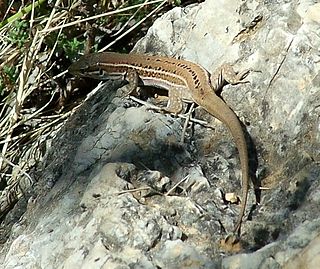
Podarcis is a genus of lizards in the family Lacertidae. Its members look very similar to lizards of the genus Lacerta, to which they were considered to belong until the 1970s. While similar externally and ecologically, Podarcis form a distinct group differing from Lacerta by the construction of the skull and the hemipenis, and by the processes of the caudal vertebrae. They are commonly known as wall lizards. They are native to Europe and northern Africa, and most species are restricted to the Mediterranean region. Wall lizards diversified and hybridized during the Messinian salinity crisis. The Italian wall lizard and the common wall lizard have been introduced to North America, where they have become intermediate hosts for some Acuariidae larvae.

The Milos wall lizard is a small Mediterranean lizard.

Ablepharus kitaibelii, also known commonly as the European copper skink, the European snake-eyed skink, the juniper skink, and the snake-eyed skink, is a species of skink, a lizard in the subfamily Eugongylinae of the family Scincidae. The species is native to Eastern Europe and Southwestern Asia.

Bedriaga's rock lizard is a species of lizard in the family Lacertidae. The species is monotypic within the genus Archaeolacerta. It is only found on the islands Corsica and Sardinia. The scientific name Lacerta bedriagae is also used. There are three recognized subspecies.

The sharp-snouted rock lizard is a species of lizard in the family Lacertidae. It is found in Bosnia and Herzegovina, Croatia, Montenegro, and possibly Albania, where its natural habitats are Mediterranean-type shrubby vegetation, rocky areas, rocky shores, rural gardens, and urban areas.

The filfola lizard or Maltese wall lizard is a species of lizard in the family Lacertidae. It is found in Italy and in the island group of Malta. Its natural habitats are Mediterranean-type shrubby vegetation, rocky areas, rocky shores, arable land, pastureland, and rural gardens.

The Skyros wall lizard is a species of lizard in the family Lacertidae. The species is endemic to the islands of Skyros and Piperi, Greece.

Lilford's wall lizard is a species of lizard in the family Lacertidae. The species is endemic to the Gymnesian Islands, the easternmost of the Balearic Islands, Spain.

The Dalmatian wall lizard is a species of lizard in the family Lacertidae. It is found in Albania, Bosnia and Herzegovina, Croatia, Italy, Serbia, Montenegro, and Slovenia. Its natural habitats are temperate forests, Mediterranean-type shrubby vegetation, rocky areas, and pastureland.

The Aeolian wall lizard, also known commonly as Raffone's wall lizard, is a species of lizard in the family Lacertidae. The species is endemic to Italy.

The Sicilian wall lizard is a species of lizard in the family Lacertidae. Endemic to Italy, it occurs in Sicily and the Aegadian Islands. Its natural habitats are temperate forests, temperate shrubland, Mediterranean-type shrubby vegetation, temperate grassland, arable land, pastureland, and rural gardens. The IUCN does not consider it to be a threatened species. Three subspecies are recognized: P. w. antoninoi, P. w. marettimensis, and P. w. waglerianus.

The European cat snake, also known as the Mediterranean cat snake, is a non venomous colubrid snake endemic to the Mediterranean and Caucasus regions.

Podarcis tauricus, the Balkan wall lizard, is a common lizard in the family Lacertidae native to southeastern Europe and Asia Minor. It is a terrestrial species found in steppe, grassland, olive groves, cultivated land, meadows, rural gardens, sparsely vegetated sand dunes and scrubby areas.

Kotschy's gecko is a species of gecko, a lizard in the family Gekkonidae. The species is native to southeastern Europe and the Middle East. It is named in honour of the Austrian botanist and explorer Theodor Kotschy.

Podarcis cretensis, the Cretan wall lizard, is a species of lacertid lizard endemic to Crete.



















